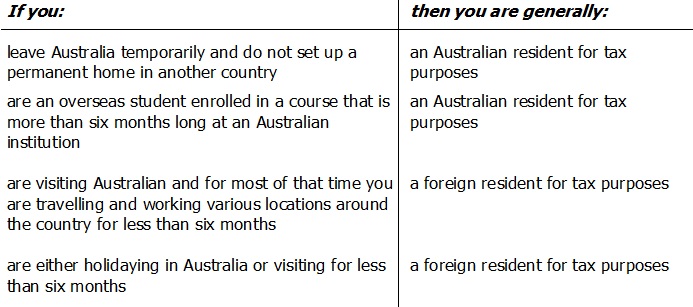Posted on August 1, 2017 by Ashley Dawson
Q: Am I a non-resident for tax purposes?
A: The ATO do not use the same rules as the Department of Immigration when determining your residency status. You can still be a resident for tax purposes even without being an Australian Citizen.
Below are some common situations that often apply when determining if you are an Australian resident or a non-resident for tax purposes:

Q: What do I have to declare in my tax return if I am a non-resident?
A: If you have been confirmed as a non-resident for tax purposes, you must declare any income earned in Australia including the following:
- Employment or wages income;
- Australian pensions or annuities;
- Rental Income;
- Any capital gains on Australian assets.
If you have a Higher Education Loan Program (HELP) or a Trade Support Loan (TSL) entered into while acting as a non-resident for tax purposes, you will need to declare your worldwide income or lodge a non-lodgement advice form.
Q: What tax rates apply if I am a non-resident for tax purposes but have earnt income from an Australian source?
A: For the 2016-2017 financial year, the following rates apply for individuals who are non-residents for tax purposes:

It is important to note that non-residents are not required to pay the Medicare Levy. However the Temporary Budget Repair Levy is still payable at a rate of 2% for taxable incomes over $180,000.
Share this:
Posted on by Ashley Dawson
Organisations are entrusted with significant power and have the ability to have a major effect on the economy, community and the environment. As such they need to be accountable for their actions, and reporting is one method for discharging this accountability.
However, traditional financial reporting is not designed to communicate to a broad range of users and specifically focuses on the shareholders and debt-holders, which are only two out of numerous stakeholders to an organisation. As such, these reports are commonly criticised as being narrow in scope in that they emphasise historical accounting profit and do not tell the full extent of the organisations broader impacts.
It now common for organisations to produce their sustainability progress as well as their financial results in a report called an annual report. A number of stock exchanges throughout the world, including Johannesburg, Singapore, Kuala Lumpur & Sao Paulo require listed companies to report on their sustainability issues or explain why they have omitted this information. In Australia it is not a requirement for listed companies to report on their sustainability issues but with increasing customer and community demands that want organisations to be liable for their actions on how they obtain their profits, many do produce an annual report.
There are three key components to producing a sustainability report and that is environmental, social and economic sustainability.
Environmental sustainability involves making responsible decisions and taking actions that are in the interests of protecting the natural world with particular emphasis on preserving the environment to support human life. Examples of environmental sustainability include;
- Climate Change: The change in global and regional climate patterns is directly linked with emission of carbon dioxide and other greenhouse gases resulting from the use of fossil fuels.
- Waste: Waste is a by-product of production that cannot be reprocessed, recovered or purified. As global commercial activities escalates, more waste is produced and discarded or released into the environment in a manner that can cause harmful change.
- Biodiversity: Ecosystems are complex and interdependent on each other, so when a business affects one element of an ecosystem, this can result in profound changes to other parts of that system.
Social sustainability can be understood as the ability of a system to continue to function at a reasonable level of social well-being. An organisation is socially sustainable when its activities not only meet the needs of its current stakeholders but also support the ability of future generations to maintain healthy communities. Examples of social sustainability include;
- Ethical Trading: Unethical trading practises may include corruption, anti-competitive behaviour, bribery, aggressive or predatory pricing, unethical marketing or unfair uses of power in markets.
- Supply Chain Management: Many multinational organisations have extensive and complex supply chains for their products. There are increasing demands for corporations to be more accountable, not only for their own activities, but also for those of the companies that supply them.
Economic sustainability is an organisation using available resources efficiently and responsibly so the organisation can continue to function over a number of years at a given level of activity. The impression is to promote the use of those resources in a way that provides long term benefits. Examples of economic sustainability include;
- Long-term viability of businesses: Reporting and financial systems are geared more towards short term. This leads to biased decision-making and a failure to manage businesses for the longer term. This has generated demands for more attention to be paid to the performance and activities of businesses in the long term.
- Stability of the economic system: The Global Financial Crisis showed how complex and interconnected our economic systems are. Economic systems are an integral part of human communities and breakdowns can have widespread consequences. Corporate behaviour can play a large role in creating a stable economic system.
Share this:


